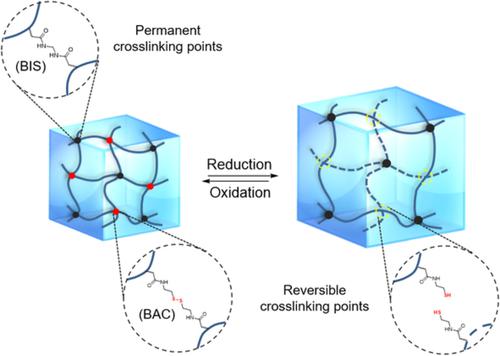当前位置:
X-MOL 学术
›
J. Polym. Sci.
›
论文详情
Our official English website, www.x-mol.net, welcomes your
feedback! (Note: you will need to create a separate account there.)
Double‐crosslinked reversible redox‐responsive hydrogels based on disulfide–thiol interchange
Journal of Polymer Science ( IF 3.9 ) Pub Date : 2019-11-14 , DOI: 10.1002/pola.29539 Yunjiao Che 1, 2 , Stefan Zschoche 1 , Franziska Obst 1, 2 , Dietmar Appelhans 1 , Brigitte Voit 1, 2
Journal of Polymer Science ( IF 3.9 ) Pub Date : 2019-11-14 , DOI: 10.1002/pola.29539 Yunjiao Che 1, 2 , Stefan Zschoche 1 , Franziska Obst 1, 2 , Dietmar Appelhans 1 , Brigitte Voit 1, 2
Affiliation

|
We present novel redox‐responsive hydrogels based on poly(N‐isopropylacrylamide) or poly(acrylamide), consisting of a reversible disulfide crosslinking agent N,N′‐bis(acryloyl)cystamine and a permanent crosslinking agent N,N′‐methylenebisacrylamide for microfluidic applications. The mechanism of swelling/deswelling behavior starts with the cleavage and reformation of disulfide bonds, leading to a change of crosslinking density and crosslinking points. Raman and ultraviolet‐visible spectroscopy confirm that conversion efficiency of thiol–disulfide interchange up to 99%. Rheological analysis reveals that the E modulus of hydrogel is dependent on the crosslinking density and can be repeatedly manipulated between high‐ and low‐stiffness states over at least 5 cycles without significant decrease. Kinetic studies showed that the mechanical strength of the gels changes as the redox reaction proceeds. This process is much faster than the autonomous diffusion in the hydrogel. Moreover, cooperative diffusion coefficient (Dcoop) indicates that the swelling process of the hydrogel is affected by the reduction reaction. Finally, this reversibly switchable redox behavior of bulky hydrogel could be proven in microstructured hydrogel dots through short‐term photopatterning process. These hydrogel dots on glass substrates also showed the desired short response time on cyclic swelling and shrinking processes known from downsized hydrogel shapes. Such stimuli‐responsive hydrogels with redox‐sensitive crosslinkers open a new pathway in exchanging analytes for sensing and separating in microfluidics applications. © 2019 Wiley Periodicals, Inc. J. Polym. Sci., Part A: Polym. Chem. 2019, 57, 2590–2601
中文翻译:

基于二硫键与硫醇互换的双交联可逆氧化还原响应水凝胶
我们提出了一种基于聚N异丙基丙烯酰胺或聚丙烯酰胺的新型氧化还原响应水凝胶,该凝胶由可逆的二硫键交联剂N,N'-双(丙烯酰基)胱胺和永久交联剂N,N'-亚甲基双丙烯酰胺组成。微流体应用。溶胀/溶胀行为的机理始于二硫键的裂解和再形成,从而导致交联密度和交联点的改变。拉曼光谱和紫外可见光谱证实,硫醇-二硫键交换的转化效率高达99%。流变分析表明,E水凝胶的模量取决于交联密度,可以在至少5个循环内在高刚度状态和低刚度状态之间重复操作,而不会明显降低。动力学研究表明,凝胶的机械强度随着氧化还原反应的进行而变化。该过程比在水凝胶中的自主扩散快得多。此外,合作扩散系数(D coop)表明水凝胶的溶胀过程受还原反应的影响。最后,可以通过短期光图案化过程在微结构化水凝胶点中证明这种可逆转换的大体积水凝胶氧化还原行为。玻璃基板上的这些水凝胶点还显示出在缩小尺寸的水凝胶形状中已知的循环溶胀和收缩过程中所需的短响应时间。这种具有氧化还原敏感性交联剂的刺激响应水凝胶为交换分析物以在微流控应用中进行传感和分离开辟了一条新途径。©2019 Wiley Periodicals,Inc.J.Polym。科学,A部分:Polym。化学 2019,57,2590年至2601年
更新日期:2019-11-14
中文翻译:

基于二硫键与硫醇互换的双交联可逆氧化还原响应水凝胶
我们提出了一种基于聚N异丙基丙烯酰胺或聚丙烯酰胺的新型氧化还原响应水凝胶,该凝胶由可逆的二硫键交联剂N,N'-双(丙烯酰基)胱胺和永久交联剂N,N'-亚甲基双丙烯酰胺组成。微流体应用。溶胀/溶胀行为的机理始于二硫键的裂解和再形成,从而导致交联密度和交联点的改变。拉曼光谱和紫外可见光谱证实,硫醇-二硫键交换的转化效率高达99%。流变分析表明,E水凝胶的模量取决于交联密度,可以在至少5个循环内在高刚度状态和低刚度状态之间重复操作,而不会明显降低。动力学研究表明,凝胶的机械强度随着氧化还原反应的进行而变化。该过程比在水凝胶中的自主扩散快得多。此外,合作扩散系数(D coop)表明水凝胶的溶胀过程受还原反应的影响。最后,可以通过短期光图案化过程在微结构化水凝胶点中证明这种可逆转换的大体积水凝胶氧化还原行为。玻璃基板上的这些水凝胶点还显示出在缩小尺寸的水凝胶形状中已知的循环溶胀和收缩过程中所需的短响应时间。这种具有氧化还原敏感性交联剂的刺激响应水凝胶为交换分析物以在微流控应用中进行传感和分离开辟了一条新途径。©2019 Wiley Periodicals,Inc.J.Polym。科学,A部分:Polym。化学 2019,57,2590年至2601年






























 京公网安备 11010802027423号
京公网安备 11010802027423号